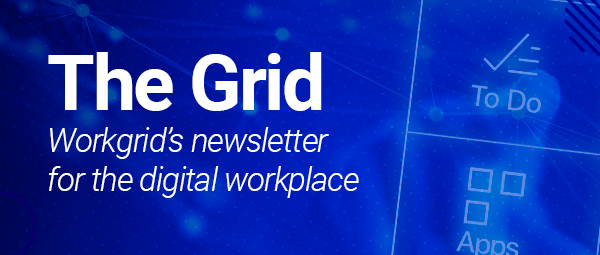Optimizing the digital workplace for a better employee experience
The concept of employee experience is ubiquitous when it comes to discussions about the digital workplace. As we’ve been told, employee experience is important to pay attention to, will be the cause of organizational downfall if it’s ignored, and employee experience strategy is heralded by all as the most important thing we should all be focusing on if we hope to achieve long-term business success.
But how do we make it better? Specifically, what kinds of digital transformation can we enact to support success in the future of work? There are actually quite a few things that can be done, but let’s start with four that will have a huge impact and can be accomplished pretty quickly and easily…
![[asset] 4 Ways the Digital Workplace Can Improve the Employee Experience](https://images.ctfassets.net/z7p73u8c0thn/17roHVruemFaxfAi25ROEG/0cda12351bb5c2aea6caddcdd6ef262b/1.png?w=600&h=350&q=60&fm=png&bg=transparent)
True digital transformation starts with delivering improvements in these four key areas
Workplace transformation: improving employee experience in 4 key areas
1. Productivity
Employees are happiest when they have time to focus on the high-value work they were hired to do. Unfortunately, the digital workplace doesn’t always support that objective. As a result of the well-intentioned trend to provide employees with an array of digital workplace solutions designed to meet every need, information workers switch windows an average of 373 times per day. That’s a lot of context switching and it has a seriously negative impact - once derailed from a task, it’s takes employees more than 23 minutes to get back on track.
The simple fact is, employees need help simplifying the work day, particularly when it comes to eliminating the number of steps it takes to complete routine tasks. There are several ways this can be accomplished.
Employee-focused, outcome-driven design
In order to improve employee productivity, it’s critical to really understand the challenges they face. Getting into the trenches with them and seeing first-hand what their daily work processes entail will make it easier to identify the inefficiencies that are currently standing in the way of a modern digital employee experience.
Let’s consider the example of requesting vacation time.
![[asset] employee-productivity-vacation-request-600x350](https://images.ctfassets.net/z7p73u8c0thn/3VlKaGF3Q1eXpo9q72KT4E/eca07b5b0c784005e6a136a3c1b77b4f/Digital_Workplace_Blog_600x350__2___1_.png?w=600&h=350&q=60&fm=png&bg=transparent)
Requesting vacation time is a time-consuming, multi-step process that has a negative long-term impact on the employee experience.
In a time when focus on employee well-being is at an all-time high, the task of requesting a vacation continues to be a frustrating task for most employees. Workers have to log into an HR system and try to find the screen they need to submit the request. Then they need to switch to Outlook to update their calendar and set an out-of-office message, notify team members in Slack or Teams that they’ll be out, update any other scheduling systems that are used, etc.
Employees need a vacation just to recover from that process!
Outcome-driven design eliminates that frustration by focusing on the end goal of what people are trying to achieve, bringing a multi-step process down into single or a few steps to save employees time and reduce friction in their work day. This isn’t about introducing new digital tools - it’s about creating a new front-end experience on top of an existing system to help employees reach their desired outcome more quickly and with less hassle.
And in case you think saving a few minutes on a single task might not seem like a big deal, consider the significance of multiplying that single task by all the times an employee performs it over the course of their employee journey. Then multiply it again by all the employees in the organization – that’s when the time savings start to really add up and the improvements to the employee experience are even more impactful. Just as an example, Liberty Mutual Insurance was able to save $7 million in reclaimed productivity as a result of modernizing their digital workplace and amplifying their intranet.
Effective use of integrations
Another way to drastically improve productivity is by creating an integrated digital work experience that gives employees access to everything they need to know and do from a single location. Integrations with the key enterprise systems employees need is a great way to accomplish this.
With effective use of integrations you can:
Provide employees with centralized access to just the functionality employees need, which maximizes investments in existing technology
Eliminate the number of steps it takes to complete tasks, improving productivity and giving workers more time for high-value work
Deliver the intuitive, consumer-grade digital experiences employees expect and need
![[gif] Smart Notifications-Igloo To Dos Approval](http://images.ctfassets.net/z7p73u8c0thn/kAd6wczrSpWysMIglF2WR/931173693a27227907d4e465df30ecea/ToDos_Approval.gif)
Links are not integrations! To truly improve the employee experience, use fully-functioning integrations that deliver targeted functionality from enterprise systems.
One word of caution though, there are some common mistakes involving the use of integrations that you should be on the lookout for. They are not all created equally, so take time and make sure to implement integrations correctly in order to reap the greatest level of benefit.
2. Communication
Communication is like the little girl in the Henry Wadsworth Longfellow poem –when it’s good, it’s very, very good, and when it’s bad, it’s horrid.
Tackling the bad news first:
According to a survey of U.S. based executives, inefficient workplace communications resulted in increased stress levels in employees (52%), failures to complete projects (44%), and low company morale (31%). Email is a particularly big offender in this, with knowledge employees spending an average of 4.1 hours checking work email each day
But that last statistic is good, right? Doesn’t it mean that email is still a vital vehicle for communicating with employees?
No. With new communication vehicles like employee communication apps, Slack and Teams, email is about as relevant as pegged jeans and feathered hair.
Well at least it means that if employees are spending so much time with email, they’re seeing communications, right? That’s also a “no.” With so much to pay attention to –much of it not even relevant - employees are overwhelmed. Those 4 hours are spent just trying to keep up and find information that they’ve archived in their inbox (you know the classic “I’ll just keep this login details email” move). Communications are getting missed and it’s a huge drain on productivity and the employee experience.
![[gif] Email-Inbox-Employee-Communication-600x350](http://images.ctfassets.net/z7p73u8c0thn/01uYFZdSrhlmvP0TrlTiw1/26ef5dc4e5aed60e3bb9473d243e8e5d/Meet_Workgrid-low.gif)
On the flip side, effective communications can turn these issues around entirely. A solid communications strategy based on modern, intelligent delivery systems can help employees feel safe, secure and connected to the organization - critically important given the impending transition back into either an office or hybrid work environment. Effective communication can also:
Increase productivity by making it easier for employees to find the information they need
Engage all employees, especially those who are the hardest to reach, such as frontline workers and employees who work in the field
Enhance the moments that matter when campaigns are personalized, contextual, and are focused on important work and personal moments, like onboarding, promotions, getting married, graduating from school etc.
So how do you improve communications to drive a better employee experience? Consider a digital workplace solution that offers the features and functionality you need to:
Aggregate all communications – including those from source systems - into a single, streamlined experience that’s coupled with important tasks that also need their attention
Make communications personalized and contextual to each employee based on their location, role, job function etc.
Enable employees to personalize their communication feeds, so they have control over what they see
Use proactive alerts to help employees know what needs their immediate attention
Make communications available via mobile, so every employee has access to the information they need to work effectively
Deliver communications across multiple channels
3. Onboarding
Onboarding is the first impression a new hire has of their new workplace and yet 88% of organizations don’t onboard well. Why? Because onboarding is an incredibly difficult and challenging process to get right. The average onboarding process involves 54 activities, spans the entire organization, and involves countless stakeholders, all of whom have their own ways of managing their portion of the process.
But the fact that onboarding is difficult to execute isn’t a pass for letting it be a lackluster experience. Bad onboarding is bad for business, leading to a 5X higher likelihood that employees will look for other job opportunities.
So how can you improve onboarding, using the process to deliver an efficient and engaging employee experience that can improve employee retention by 82%
There are a number of best practices for creating an ideal, employee-first onboarding experience. Let’s take a look at a few of them now…
Centralize onboarding tasks and information
Simplify onboarding by creating automated processes that consolidates everything employees need to know and take action on from across the enterprise - such as procedures, enrollments and trainings - into a streamlined, easy-to-understand experience. By automating the entire onboarding process, employees get a clear and engaging onboarding experience that results in higher satisfaction and improved retention rates.
![[asset] Employee-Onboarding-Image-Oracle](https://images.ctfassets.net/z7p73u8c0thn/4omH3OFYQZgz6gGv9xSp1X/5e19112859f151d173b5acf428b6d2e9/Employee_Onboarding_Image_Blue.png?w=735&h=650&q=60&fm=png&bg=transparent)
Engage employees from the beginning
Take advantage of the momentum and good will gained during the hiring process to engage employees as soon as they accept their offer letter, using personalized communications such as team introductions, localized parking instructions and welcome videos from the CEO.
This type of early connection not only validates an employee’s decision to join your organization, it makes every new employee feel like a welcomed and valued member of the team, increasing the likelihood that they’ll stay with the company for the long-term.
4. Flexible work
The statistics are clear: the era of working in an office 5 days a week are over for most employees, with hybrid work models becoming the norm.
Thankfully, research shows that remote workers are 35% to 40% more productive than their in-office counterparts.
Employees are getting the job done (literally), so how can business leaders support them and provide the digital workplace solutions they expect and need?
To start, organizations should focus on providing employees with modern digital experiences that enable employees to work wherever and whenever it’s convenient for them. Empowering employees with this sort of flexibility delivers significant employee experience benefits, helping employees better manage work-life balance, improve their wellness and be more productive.
But that doesn’t mean you can just deploy a bunch of different digital tools (ADP, ServiceNow, Workday, etc.) in the name of flexibility. The complexity of the digital workplace is bad enough as it is. With business units implementing technology in silos based on their own needs - without regard for their impact to the overall digital employee experience - the result is frustrated employees and a fragmented experience.
![[asset] Workplace Complexity](https://images.ctfassets.net/z7p73u8c0thn/4YOsYtJke4TV9qiuEpy6ir/d4f231a7bcc7beb9355d2d09d2b9cf2c/WorkplaceComplexity.jfif?w=1200&h=527&fl=progressive&q=60&fm=jpg&bg=transparent)
Tech sprawl is a real thing and the impact is disastrous for employees, damaging productivity, engagement and the digital employee experience as a whole.
So how can you provide a robust and seamless digital employee experience that’s capable of handling the future of work?
By implementing solutions that help employees be effective no matter where they are.
Give employees modern, digital tools that make it easy for them to work how and when it’s convenient for them. This should start with centralizing access to the most important things they need to know and do, from communications and notifications to tasks and information from core systems. The ideal employee experience platform will deliver:
Streamlined communications
Information is the currency of effective remote work. The more organizations can provide employees with targeted, contextual communications and updates, the more connected and engaged their workforce will feel.Flexible access to key enterprise systems
Integrate with core HR, IT and Finance systems to abstract important tasks, notifications and information and present it in a central location so employees can be more productive than ever before.Self-service functionality & automation
Remote work shouldn’t be less productive work. Organizations can help employees be more effective by making it easier to complete the routine tasks that are related to their jobs. A chatbot can help, automating access to tasks and information and making it easy to submit time off requests, submit help desk requests and more.
The right digital workplace solution will also meet employees where they are, with flexible, multi-channel access that puts everything they need to know and do right at their fingertips, whenever they need it.
![[asset] office-holiday-hero](https://images.ctfassets.net/z7p73u8c0thn/148jPE0zAd27BA9tBN1rwR/1bfbe384497ee02985a3a84fd1f64fee/office-holiday-hero.png?w=1200&h=1061&q=60&fm=png&bg=transparent)
Preparing the digital employee experience for the future of work
Giving employees the modern digital workplace solutions they need to be effective in this new world of work might sound daunting, but it doesn’t have to be - Workgrid can help. To see how you can deliver a superior digital employee experience, check out this guided tour.

![[asset] Flexible Work Statistics 2021](https://images.ctfassets.net/z7p73u8c0thn/3OsHrociDfsoTmGZKOdVTp/f7a4b08f7e1dfbb29f5ad70749ef6155/2.png?w=600&h=350&q=60&fm=png&bg=transparent)



